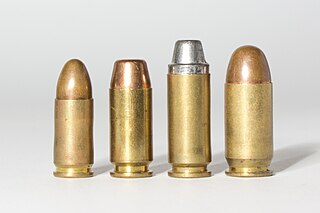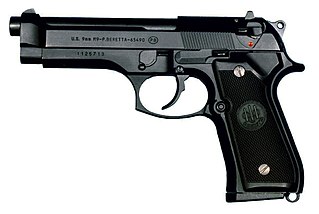Related Research Articles

A submachine gun (SMG) is a magazine-fed automatic carbine designed to fire handgun cartridges. The term "submachine gun" was coined by John T. Thompson, the inventor of the Thompson submachine gun, to describe its design concept as an automatic firearm with notably less firepower than a machine gun. As a machine gun must fire rifle cartridges to be classified as such, submachine guns are not considered machine guns.

In firearms terminology, an action is the functional mechanism of a breech-loading firearm that handles the ammunition cartridges, or the method by which that mechanism works. Actions are technically not present on muzzleloaders, as all those are single-shot firearms with a closed off breech with the powder and projectile manually loaded from the muzzle. Instead, the muzzleloader ignition mechanism is referred to as the lock.

The Colt M1911 is a single-action, recoil-operated, semi-automatic pistol chambered for the .45 ACP cartridge. The pistol's formal U.S. military designation as of 1940 was Automatic Pistol, Caliber .45, M1911 for the original model adopted in March 1911, and Automatic Pistol, Caliber .45, M1911A1 for the improved M1911A1 model which entered service in 1926. The designation changed to Pistol, Caliber .45, Automatic, M1911A1 in the Vietnam War era.
A semi-automatic firearm, also called a self-loading or autoloading firearm, is a repeating firearm whose action mechanism automatically loads a following round of cartridge into the chamber and prepares it for subsequent firing, but requires the shooter to manually actuate the trigger in order to discharge each shot. Typically, this involves the weapon's action utilizing the excess energy released during the preceding shot to unlock and move the bolt, extracting and ejecting the spent cartridge case from the chamber, re-cocking the firing mechanism, and loading a new cartridge into the firing chamber, all without input from the user. To fire again, however, the user must actively release the trigger, and allow it to "reset", before pulling the trigger again to fire off the next round. As a result, each trigger pull only discharges a single round from a semi-automatic weapon, as opposed to a fully automatic weapon, which will shoot continuously as long as the ammunition is replete and the trigger is kept depressed.

A semi-automatic pistol is a handgun that automatically ejects and loads cartridges in its chamber after every shot fired. Only one round of ammunition is fired each time the trigger is pulled, as the pistol's fire control group disconnects the trigger mechanism from the firing pin/striker until the trigger has been released and reset.

The .45 ACP, also known as .45 Auto, .45 Automatic, or 11.43×23mm is a rimless straight-walled handgun cartridge designed by John Moses Browning in 1904, for use in his prototype Colt semi-automatic pistol. After successful military trials, it was adopted as the standard chambering for Colt's M1911 pistol. The round was developed due to a lack of stopping power experienced in the Moro Rebellion in places like Sulu. The issued ammunition, .38 Long Colt, had proved inadequate, motivating the search for a better cartridge. This experience and the Thompson–LaGarde Tests of 1904 led the Army and the Cavalry to decide that a minimum of .45 caliber was required in a new handgun cartridge.

The .380 ACP, is a rimless, straight-walled pistol cartridge that was developed by firearms designer John Moses Browning. The cartridge headspaces on the mouth of the case. It was introduced in 1908 by Colt, for use in its new Colt Model 1903 Pocket Hammerless semi-automatic, and has been a popular self-defense cartridge ever since, seeing wide use in numerous handguns. Other names for .380 ACP include .380 Auto, 9×17mm, 9mm Browning, 9mm Corto, 9mm Kurz, 9mm Short, and 9mm Browning Court. It should not be confused with .38 ACP. The .380 ACP does not strictly conform to cartridge naming conventions, named after the diameter of the bullet, as the actual bullet diameter of the .380 ACP is .355 inches.

The 9×19mm Parabellum is a rimless, centerfire, tapered firearms cartridge.

An automatic firearm or fully automatic firearm is a self-loading firearm that continuously chambers and fires rounds when the trigger mechanism is actuated. The action of an automatic firearm is capable of harvesting the excess energy released from a previous discharge to feed a new ammunition round into the chamber, and then igniting the propellant and discharging the projectile by delivering a hammer or striker impact on the primer.

The Pedersen device was an experimental weapon attachment for the M1903 Springfield bolt action rifle that allowed it to fire a .30 caliber (7.62 mm) pistol-type cartridge in semi-automatic mode. The attachment was developed to allow an infantryman to convert "their rifle to a form of submachine gun or automatic rifle" in approximately 15 seconds.
Blowback is a system of operation for self-loading firearms that obtains energy from the motion of the cartridge case as it is pushed to the rear by expanding gas created by the ignition of the propellant charge.

The Remington Model 51 is a small pocket pistol designed by John Pedersen and manufactured by Remington Arms in the early 20th century for the American civilian market. Remington manufactured approximately 65,000 Model 51 pistols in .32 ACP and .380 ACP calibers from 1918 to 1926, though small numbers were assembled into the mid-1930s.

The Joint Service Small Arms Program, abbreviated JSSAP, was created to coordinate weapon standardization between the various United States armed service branches.

The Grizzly Win Mag pistols were conceived, invented, designed, engineered and developed in the 1980s by the sole inventor, Perry Arnett, who licensed his patent for an interchangeable caliber semi-automatic pistol to L.A.R. Manufacturing Inc. Perry Arnett's designs were initially flawed and were improved upon by Heinz Augat. The L.A.R. Grizzly was the most powerful semi-automatic pistol ever commercially produced after the Desert Eagle.

A handgun is a firearm designed to be usable with only one hand. It is distinguished from a long gun which needs to be held by both hands and braced against the shoulder. Handguns have shorter effective ranges compared to long guns, and are much harder to shoot accurately. While most early handguns are single-shot pistols, the two most common types of handguns used in modern times are revolvers and semi-automatic pistols, although other handguns such as derringers and machine pistols also see infrequent usage.

The 9×25mm Mauser is a cartridge developed for the Mauser C96 service pistol around 1904 by DWM. Mauser pistols in this relatively powerful caliber were primarily intended for export to Africa, Asia, and South America. The 9mm Mauser Export cartridge was produced specifically for Mauser pistols and carbines made from 1904 to 1914 and then later from approximately 1930 to 1945 for submachine guns chambered for this caliber.
The AS-44 is a series of prototype Soviet assault rifles designed and developed by Alexey Sudayev in 1944—1945, they were produced in limited numbers and tested in 1944—1945, but its development ended in 1946 due to the death of its designer.
The Mambi-1 AMR is a semi-automatic anti-materiel rifle designed and manufactured in Cuba. It was named after the Mambises, who were rebel soldiers that fought against the Kingdom of Spain during the Cuban War of Independence (1895–1898).

The .22 TCM or 22TCM is a proprietary bottle-necked rimless cartridge created from a 5.56mm NATO / 223 Rem parent case. Developed by custom gunsmith Fred Craig and Martin Tuason, President of Rock Island Armory (RIA) Armscor. Used in the RIA M1911 pistols, and the M22 TCM bolt-action rifle. Before the cartridge was commercialized, it was called the 22 Micro-Mag. Similar concept to other bottle-necked pistol cartridges such as 7.62x25mm Tokarev, and FN 5.7x28mm. The 22TCM trades bullet mass for increased velocity and lower recoil.
The Antonov E-153 was a prototype Soviet experimental fighter designed by Oleg Antonov.
References
- ↑ Александр (2023-02-12). "Оружейная экзотика. (Нереализованные проекты, опытная и малоизвестная серийная военная техника): Опытный пистолет-пулемёт класса PDW Colt SCAMP (США. 1969 - 1971 год)". Оружейная экзотика. (Нереализованные проекты, опытная и малоизвестная серийная военная техника). Archived from the original on 2024-02-05. Retrieved 2024-02-05.
- 1 2 3 4 5 6 7 8 9 Kitsune. "Colt Scamp (Small Caliber Machine Pistol)". Archived from the original on March 14, 2017. Retrieved September 1, 2013.
- 1 2 3 4 5 6 7 8 Truby, J.David (May 2004). "Building a Better Man Trap: The Colt SCAMP". Small Arms Review. 7 (8): 26–28.
- ↑ Watters, Daniel E. "The 5.56 X 45mm: 1970-1973". thegunzone.com. Archived from the original on 2012-09-25. Retrieved September 1, 2013.